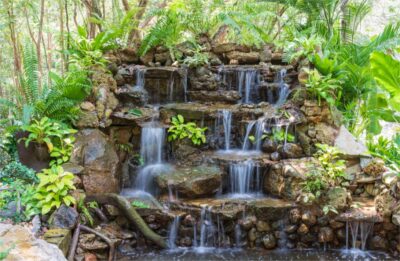
The main purpose of a retention pond is the help store excess water that runoff – these ponds a permanent structures that are made artificially. In some places, this retention pond is also known as retention basin, wet pond, wet detention pond, stormwater pond, and best management practice. Regardless of the name that you decide to call your own retention pond, the purpose of the pond will always remain the same; and that is to ensure that excess water is stored, to help better segmentation, and ensure that flooding tendencies is reduced.
Retention pond VS detention pond
Sometimes, people tend to confuse these two points as the same thing. Like we said in the introduction above, retention pond can also be called wet detention pond. For that reason, some people tend to confuse detention ponds with retention ponds. Normally, detention ponds are usually dry, and they are for short term purposes. In difference between the two types of pond is one is wet at all times, and one is dry sometimes.
the reason why a retention pond remains wet all the time, is because it is regularly storing excess water. A detention pond is mostly dry because it is only used to store water for a short period. The process of building the tool types of pond is different, because one is permanent and the other can be temporary. However, they both serve the ultimate goal of ensuring that the water that is stored is filtered before it is released.
How do retention pond work?
Because the outflow is controlled and limited to acceptable levels for the local runoff rate, retention ponds are effective. The construction may include pipes, weirs, and different orifices to help control the outflow. If massive underground pipes are utilized to retain stormwater runoff, these pipes feed into a smaller pipe that has a purposefully tiny diameter to regulate the outflow as necessary.
Retention pond design and construction
Like we said in the section above, retention pond are permanent structures, So the building process has to ensure that the structure can last for long. retention pond can be built in any location, and people mostly see this type of pond in their vicinity, shopping centers, and business parks. One thing to note about this type of pond is that they require a large mass of land to build. if the land will not be enough to build a proper retention pond, an engineer would recommend alternatives such as subsurface stormwater system. However, retention pond represents an option that is more traditional and well known as the best management practice, and it is quite popular in areas around the Mid-Atlantic.

Step by step retention pond construction in Virginia beach
Recently in kempsville, the constructor the new 4th precinct building, Behind the former structure that was in the building. in order to make the whole construction more beautiful, they also constructed a playground and a larger parking lot. However, to keep all of these structures running properly, the retention pond has to be enlarged. The major downside of this location was the fact that, it is an area with a high water table, so the engineer had to make several changes to his design TO accommodate the situation at hand.
Step 1: install PVC liner
The first step in building a well constructed retention pond is to ensure that the site is properly cleared. The construction workers removed the previous pond that was situated in the environment, and prepare that space to receive a new PVC liner.
Polyvinyl chloride is what is known as PVC. The main purpose of this liners is to ensure that the waste and chemical is separated from the water; for the liner to be effective in doing this, it hard to be very strong, flexible, and impermeable. Majorly, PVC liners are mostly used during the construction of stormwater ponds or land fillings.
However, PVC liner is not important for all types of retention ponds. the reason why a liner was used during the construction of this retention pond is the high water table in the environment. with a very strong PVC liner that is impermeable, the tendency of the groundwater system getting contaminated is reduced. As the excess water tends to rush in to the retention pond, the sediment in the water will settle down, but it will not infiltrate the groundwater system.
The PVC liner installed in the retention pond in Virginia beach was 50 mil. However, it is impossible for you to install a liner in a pond that already has water. Before you can install a liner properly, the pond needs to be dry. After the constructors were able to dry the pond, they installed a PVC liner of 44,000 square feet.
In most cases, the liner used in the retention pond, Is usually constructed to fit in to the site requirement.
Step 2: install geotextile
Once the contractor and his engineers were able to install the PVC liner, the next step was to install a nonwoven geotextile of 8oz on the liner. The main purpose of this geotextile is to ensure that the liner is protected from being punctured, and it is cautioned to remain in place. If a liner is punctured, it would give room for dirt to contaminate the groundwater system. In essence, the retention pond would become immediately useless, and its function would be driven away.
Liner installation followed by geotextile
At first, the constructors will first excavate a miniature trench around the pond. The trench will then be filled with rocks, and it will serve as a limit for the water to reach when it is rising. Then, they will line the trench with a 4oz nonwoven geotextile, This process is known as installing the drainage fabric. This nonwoven geotextile that is installed, Will separate The Dirty from the water, so as to give the water a natural flow. Basically, so we will be separated from rip rap.
Trenched perimeter with nonwoven geotextile
The miniature trench that was installed will also serve as a slope interrupter. once the excess water starts flowing along the slope into the retention pond, the miniature trench will ensure that velocity of the water is reduced. This is important to prevent erosion of the pond banks. Also, some sediments that will be included in the water that is running off into the pond will be absorbed by the trench, that would reduce the amount of sediment that would enter the pond.
Step 3: install gabion baskets
The next line of action after installing the geotextile, Is to install gabion baskets. The baskets that were installed in this retention pond were nine PVC coated, and it was installed at the inlet to the pond. Mainly, the baskets are filled with rocks, and it will act as the ponds forebays. These forebays Will reduce the amount of sediments in the water, and also slow down the water velocity, making maintenance process easier.
Step 4: install erosion control blanket and plants
The next step is to install an erosion control blanket to stabilize the slopes; the blanket installed in this pond was a single net straw. The last step is to plant wetland plants, so that they can absorb any excess nutrients from the water.
Threats and design challenges
Regardless of the amount of plant that is planted in this pond, it is possible for the pond to still experience erosion. One of the challenges that retention pond can face is a strong windstorm. this windstorm can create small waves that will cause erosion to the lakes banks. The size of the waves is not what causes the deficiency, it is the consistency of the wave action. However, this challenge can be attacked beforehand by installing coir logs around the ponds perimeters. This installation will ensure that the banks of the pond is protected from erosion, and the waves will be deflected.
Retention pond maintenance
The maintenance system that is required in a retention pond is higher than a dry pond, and that is majorly because the retention pond is a permanent water source. The maintenance process is expected to be carried out by the owner of the pond. Basically, the pond would require everyday maintenance and post storm check-ins from the owner.
General maintenance process involves:
- Ensuring the trash is cleaned from inside the pond and around the pond.
- Properly vegetating the plants that surrounds the pond.
- Regularly checking the forebays To see the accumulated sediments, and clean it up.
- putting measures in place to prevent erosion.
Currently, there are several companies in the world that specialize in the building and maintenance of retention pond. You can search online for these companies if you want them to build a retention pond for you or maintain your pond.
Conclusion
The beautification that is employed to some retention ponds will make them appear aesthetic. however, the function of the aesthetic bonds and the ones that are not remains the same; that is to act as a storm water management. The design, construction, and maintenance of the pond are all streamlined to fit the site. This simply means, that you cannot implement another retention pond design in another site. One of the best ways to ensure that the retention pond last for long, is the celeb the best erosion control And geosynthetic materials. If you are able to select the best of these materials, you will give your pond the best chance of not getting contaminated, and the tendency of erosion would be reduced completely.









